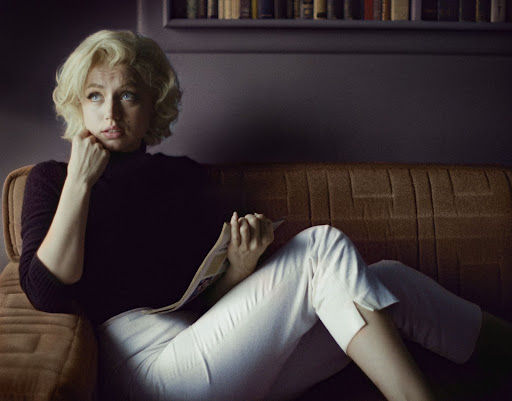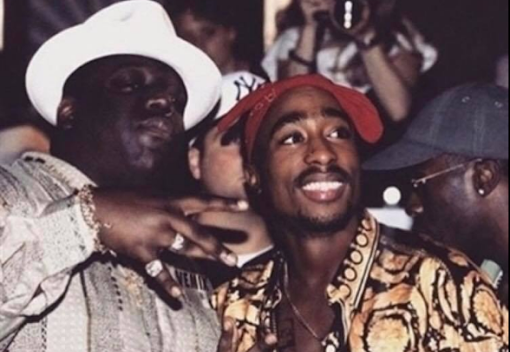Blonde: A Biopic With An Agenda

Ana De Armas as Marilyn Monroe
It’s easy to take every single word as fact while watching a biopic. We all think the same thing: “This movie wouldn’t lie to me. It’s based on someone’s life.” That’s why I was left staring at my TV screen, confused while watching Netflix’s Blonde. The year 2022 was a highly anticipated year for movies. More specifically, for biopics. If you’re unfamiliar with the term, a biopic is a movie that depicts and dramatizes the life of a living person or historical figure. Notable examples from recent years include Judy (2019), Jackie (2016), and Bohemian Rhapsody (2018). The year 2022 was no different with the release of box office hit Elvis, and the series Dahmer and Pam and Tommy being released to streaming platforms. So it was only a matter of time before there was a biopic about one of America’s most recognizable pop culture icons, Marilyn Monroe.
Blonde is not the first biopic to cover Marilyn Monroe, with films such as Marilyn and Me (1991) and My Week With Marilyn (2011) coming before. However, what differed those films from Blonde was that they portrayed Marilyn not as the protagonist, but rather as a figure seen through the protagonists’ eyes. To be more specific, those films over sexualized Monroe to the extent that they made her into a caricature of a human being. So, I was excited to see a film that showcased Marilyn as a real person, and not just as the iconic figure we are all already familiar with. Unfortunately, Blonde was one of the biggest cinematic disappointments of 2022.
Blonde was a film that was studded with a variety of issues amongst the amazing acting, superb costuming, and impressive cinematography. But the issue that a majority of viewers had with the film was actually one that didn’t seem significant to me at all: the casting of Ana de Armas as Marilyn Monroe. Many raised the issue that a non-American actress was portraying such an iconic American figure on screen. However, I personally think that Ana de Armas was a great casting choice and is not what was wrong with this film. Think of the phrase, “there are bigger fish to fry.”
For starters, Blonde is based off of a book with the same title by Joyce Carol Oates that is a fictionalized take on Marilyn Monroe’s life. So when watching a biopic that portrays completely made up events, it not only leaves viewers with wrong information, but it tarnishes the legacy of the person it portrays. It would be one thing if the film was complete fiction, but the film also incorporates real events into the story. This leaves viewers with a film that is a fusion of fact and fiction. For example, the film begins with a young Marilyn Monroe being physically abused by her mentally ill mother before she attempts to kill her. While this gives viewers a reason to root for Marilyn, it is also not entirely true. Although Marilyn Monroe’s mother, Gladys Baker, was diagnosed with paranoid schizophrenia and was admitted to a mental hospital when Marilyn was young, there is no evidence that she ever tried to kill her daughter. Similarly, the film portrays Marilyn getting a forced abortion after an accidental pregnancy which shapes her character for the rest of the film because of her trauma. However, the rumor that Marilyn had an abortion during her lifetime was purely speculation. To me at least, depicting fake events feels unnecessary.

Another issue I had with the film was the overall angle it took. And after looking online, I’m not alone in my opinion. The film was undertaken by director Andrew Dominik, who also wrote the screenplay, and his take on Marilyn was confusing to say the least. The portrayal of Marilyn Monroe in this film, which I had been excited to see the direction of, left me along with many other viewers not only confused but angered. It felt as if Dominik had something against Monroe based off of the way he portrayed her. With a prominent emphasis on the duality of her character, how the glamorous image of Marilyn Monroe is just a facade and how she is truly just the orphaned Norma Jean Baker, there was definitely a lot of room to explore the depth behind her seemingly ditzy persona. But Dominik chose to write Marilyn exactly the way many see her: a dumb blonde. There was no difference in the way that Marilyn acted on screen versus off screen with her character coming off as unintelligent, childish, and almost unrealistically clueless. In reality, Marilyn Monroe was said to be a very well spoken and intelligent woman but was sadly always typecast as the funny and ditzy blonde. Along with this, Dominik depicts Monroe as having many mental breakdowns on the sets of movies, portraying a scene where the actress cuts her face with her fingernails when she messes up a scene. Unsurprisingly, this was untrue. While the actress reportedly had difficulty memorizing her lines due to her dyslexia, there is no evidence that points to her having meltdowns like this on set. Director Billy Wilder, who worked with Monroe on films such as Some Like it Hot (1959) and The Seven Year Itch (1955) stated in Cameron Crowe’s Conversations With Wilder, “But if she showed up, she delivered, and if it took eighty takes, I lived with eighty takes, because the eighty-first was very good.” Author Sarah Churchwell, who has done in depth studies on Monroe’s life and wrote The Many Lives of Marilyn Monroe, writes, “The biggest myth is that she was dumb. The second is that she was fragile. The third is that she couldn’t act. She was far from dumb, although she was not formally educated, and she was very sensitive about that. But she was very smart indeed – and very tough. She had to be both to beat the Hollywood studio system in the 1950s. The head of Fox Studios was incredibly contemptuous of her, and she fought him tooth and nail and won, in real terms. She was very witty with an acidic sense of humor. The dumb blonde was a role – she was an actress, for heaven’s sake!” There were also sexual scenes that got very graphic in the film which almost objectified Marilyn. It felt as if Dominik had done no research on what the actress was actually like and instead, ran with his perception of her.
I think what was the most frustrating about Blonde, was the idea that even today, Marilyn Monroe is still being persecuted by the media. During the 1950s and 1960s, for a woman to be so comfortable in her sexuality was seen as taboo, and therefore, Marilyn was highly criticized by the press. However, I was excited to see a modern film that portrayed Marilyn positively, rather than one that pushed the same narrative that has been around for 70 years. Overall, this film made a mockery of one of America’s most beloved icons and tarnished her legacy for a new generation. The last thing we need is another Marilyn Monroe story portrayed through a misogynistic lens.
by Chloe Stefani ’24, Fashion Editor
24cstefani@montroseschool.org








